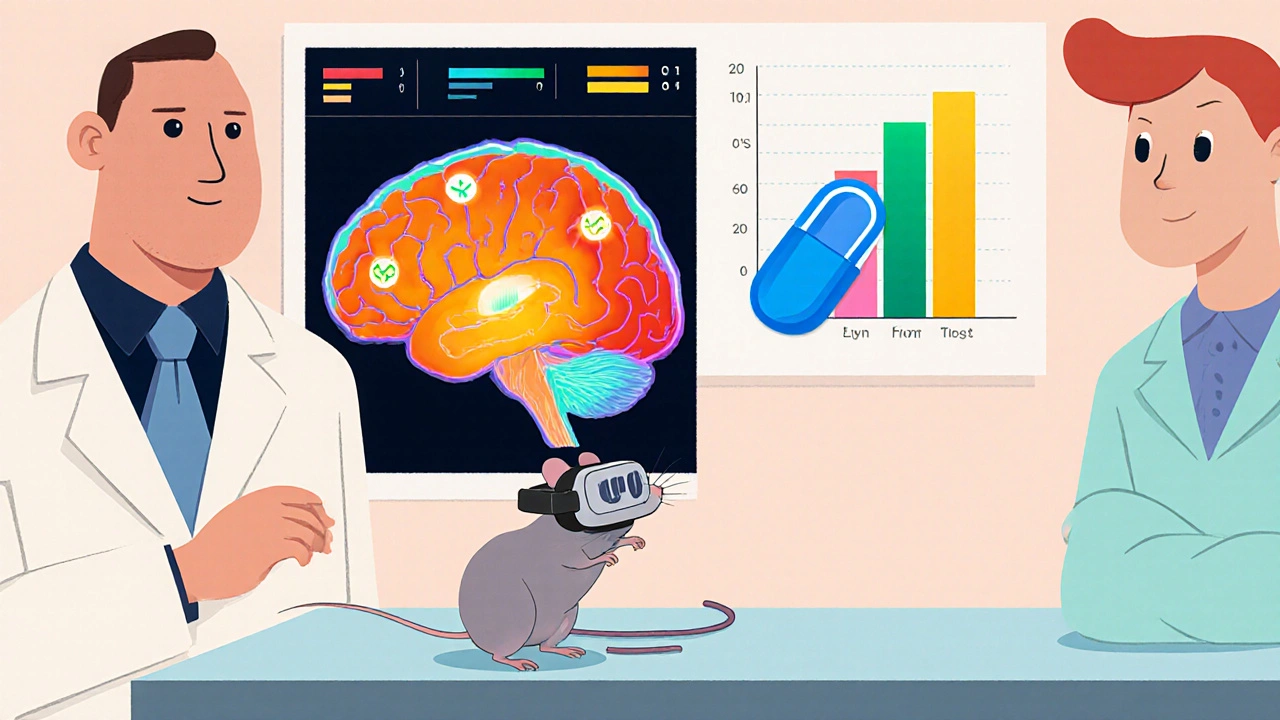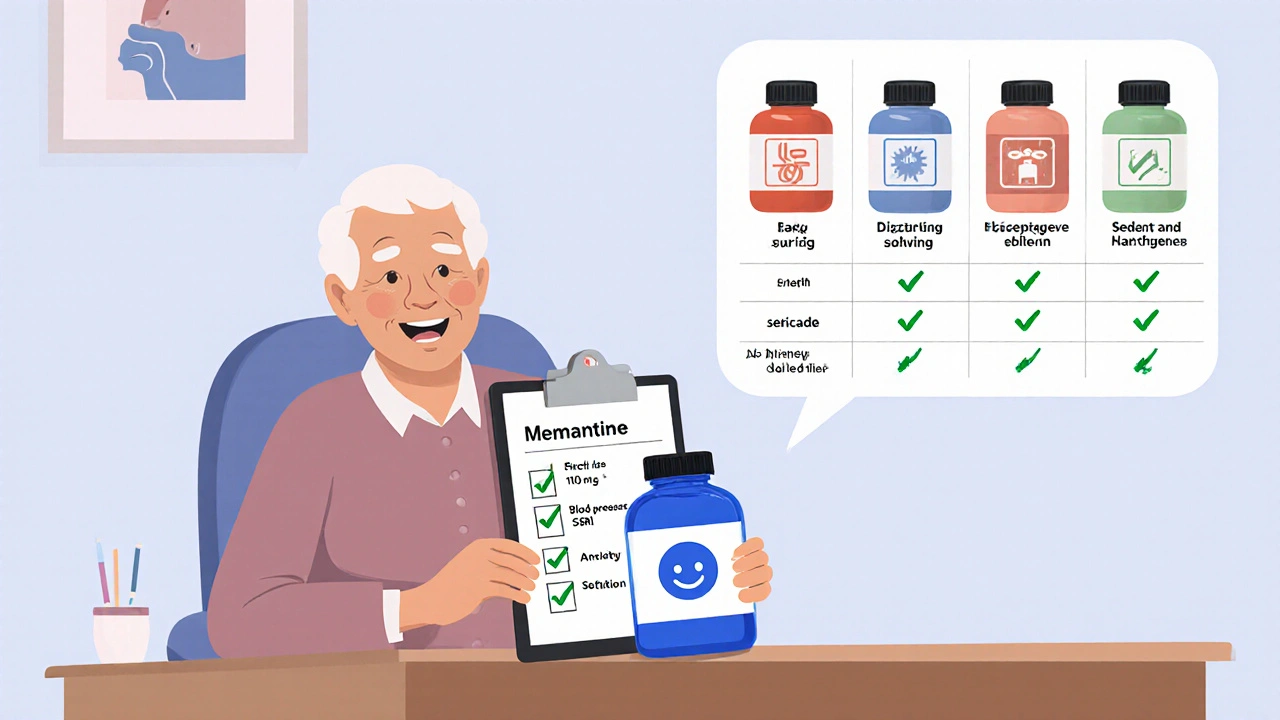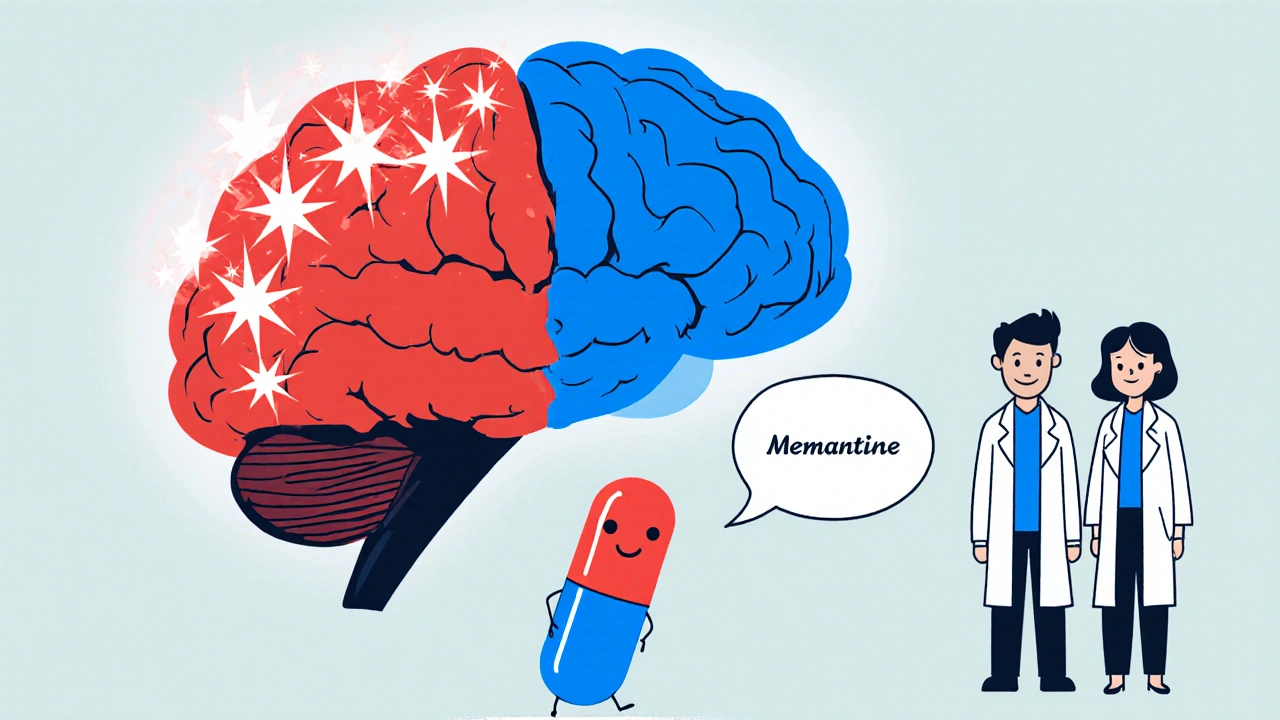When we talk about Memantine is a low‑affinity NMDA receptor antagonist approved for moderate‑to‑severe Alzheimer’s disease, many think only of memory loss.
Recent research asks whether memantine can also calm the nervous system in anxiety.
What Is Memantine?
Memantine (brand name Namenda) belongs to a class of drugs called NMDA (N‑methyl‑D‑aspartate) receptor antagonists. By binding to the NMDA receptor’s ion channel, it reduces excessive calcium influx caused by glutamate overstimulation. The drug’s low affinity means it blocks only the pathological activation while sparing normal neurotransmission, a balance that underpins its safety profile in Alzheimer’s patients.
How Does Memantine Work in the Brain?
Glutamate is the brain’s primary excitatory neurotransmitter. In healthy conditions it helps with learning and memory. When glutamate levels rise too high, the NMDA receptor stays open longer than it should, leading to neuronal stress and, over time, cell death. Memantine’s selective blockade thwarts this cascade.
Because anxiety also involves heightened glutamatergic activity-especially in the amygdala and prefrontal cortex-researchers hypothesize that dampening NMDA‑mediated excitability could reduce anxiety symptoms without the sedation typical of many anxiolytics.
Anxiety: Causes and Current Treatments
Generalized anxiety disorder (GAD), panic disorder, and social anxiety share a common thread: hyper‑reactivity of the limbic system. Genetic predisposition, chronic stress, and dysregulated neurotransmitters (serotonin, norepinephrine, and glutamate) all play a role.
First‑line pharmacotherapy usually involves SSRIs (selective serotonin reuptake inhibitors) such as sertraline or escitalopram, which increase serotonin availability. Benzodiazepines (e.g., lorazepam) act on GABA‑A receptors to produce rapid calm but carry dependence risk.
When patients cannot tolerate these options-due to side effects, drug interactions, or inadequate response-clinicians look for off‑label alternatives.

Why Researchers Look at Mem‑NMDA receptor Antagonists for Anxiety
Several lines of evidence point toward NMDA antagonism as a viable strategy:
- Animal models: Ketamine, a high‑affinity NMDA blocker, produces rapid, robust anxiolysis in rodents.
- Human imaging: Elevated glutamate concentrations in the anterior cingulate cortex have been correlated with anxiety severity.
- Clinical anecdotes: Small case series report reduced anxiety scores in patients receiving memantine for cognitive disorders.
Memantine’s gentler pharmacology makes it an attractive candidate-potentially offering anxiety relief without ketamine’s dissociative side effects.
Clinical Evidence and Study Findings
To date, only a handful of controlled studies have examined memantine for anxiety:
- Open‑label pilot (2022, n=30): Adults with treatment‑resistant GAD received 10 mg memantine daily for six weeks. Mean Hamilton Anxiety Rating Scale (HAM‑A) scores dropped from 24 to 14, a 42 % reduction.
- Randomized double‑blind trial (2023, n=84): Participants with comorbid Alzheimer’s and anxiety were assigned memantine 20 mg or placebo. The memantine arm showed a statistically significant improvement in the Neuropsychiatric Inventory‑Anxiety subscale (‑2.1 vs. -0.5, p = 0.03).
- Case‑report series (2024, n=5): Patients with severe social anxiety who failed SSRIs experienced a 30‑40 % reduction in Social Phobia Inventory scores after adjunctive memantine 15 mg.
While promising, these studies share limitations: small sample sizes, short follow‑up, and heterogeneous populations. No large‑scale phase III trial has yet confirmed efficacy.
Potential Benefits Over Traditional Anxiolytics
| Feature | Memantine | SSRIs | Benzodiazepines |
|---|---|---|---|
| Primary Mechanism | NMDA‑receptor antagonist (glutamate modulation) | Serotonin reuptake inhibition | GABA‑A positive allosteric modulation |
| Onset of Action | 2‑4 weeks (similar to SSRIs) | 2‑6 weeks | Minutes to hours |
| Typical Side Effects | Dizziness, headache, constipation | Nausea, sexual dysfunction, insomnia | Sedation, cognitive impairment, dependence |
| FDA Approval for Anxiety | No (off‑label) | Yes (major depressive disorder, GAD) | Yes (short‑term anxiety) |
| Abuse Potential | Low | Low | High |
For patients wary of sedation or dependency, memantine’s side‑effect profile may be preferable. Moreover, its dual benefit for cognition (in Alzheimer’s) can be an added value for older adults with mixed presentations.

Risks, Contra‑indications, and Monitoring
Although memantine is generally well‑tolerated, clinicians should watch for:
- Hypotension or hypertension spikes, especially when combined with antihypertensives.
- Renal impairment: dosage reduction is recommended for eGFR < 30 mL/min.
- Potential drug‑drug interactions with anticholinergics or other NMDA antagonists.
The FDA has not approved memantine for anxiety, so prescribing it off‑label requires informed consent and clear documentation of expected benefits and risks.
Practical Considerations for Patients and Clinicians
When contemplating memantine as an adjunct or alternative:
- Assess prior treatment response: memantine may be most useful after SSRIs and benzodiazepines have failed or caused intolerable side effects.
- Start low: a typical titration begins at 5 mg daily, increasing to 10-20 mg as tolerated.
- Monitor anxiety scales (HAM‑A, GAD‑7) every 2-4 weeks to gauge efficacy.
- Schedule renal function labs at baseline and after 3 months.
- Educate patients that benefits may take several weeks-unlike benzodiazepines, there is no immediate calming effect.
Collaboration with a psychiatrist can help fine‑tune dosing and assess whether the cognitive benefits observed in dementia translate to anxiety‑only populations.
Bottom Line
Memantine’s unique glutamate‑modulating action offers a plausible pathway to reduce anxiety, especially for individuals who cannot tolerate conventional drugs. Early studies show modest symptom improvement and a favorable safety profile, but high‑quality trials are still missing. Until such data emerge, clinicians should view memantine as an off‑label option reserved for carefully selected patients, with thorough monitoring and clear communication about the experimental nature of its use for anxiety.
Can memantine be used alone for anxiety?
Most clinicians combine memantine with a standard anxiolytic or use it after other treatments have failed. The evidence base is limited, so using it as a sole agent is generally discouraged until more data are available.
What dosage is typically studied for anxiety?
Trials have used 10 mg to 20 mg daily, often starting at 5 mg and titrating up over 2-3 weeks to minimize side effects.
Are there specific populations that might benefit most?
Older adults with co‑existing cognitive decline and anxiety appear to gain both mood and memory benefits. Younger patients with treatment‑resistant GAD may also respond, but data are sparse.
How does memantine differ from ketamine?
Ketamine binds tightly to NMDA receptors and produces rapid, often dissociative, effects. Memantine is a low‑affinity blocker, offering a steadier modulation without the psychotomimetic experience.
What monitoring is required when prescribing memantine off‑label?
Baseline renal function, blood pressure checks, and periodic anxiety‑scale assessments are recommended. Any emerging side effects such as dizziness or gastrointestinal upset should trigger dose reassessment.


Comments (6)
Chirag Muthoo
October 21, 2025 AT 19:29Thank you for presenting a thorough overview of memantine's potential role in anxiety management. The tone remains balanced, acknowledging both the promise and the current limitations of the evidence. I appreciate the emphasis on careful patient selection and monitoring. This approach aligns well with best practices in off‑label prescribing.
Harry Bhullar
October 31, 2025 AT 19:29From a pharmacological perspective, it’s worth unpacking why memantine might affect anxiety circuits in the first place. The NMDA receptor is central to excitatory neurotransmission, and its overactivation can lead to heightened neuronal firing within the amygdala, a region heavily implicated in fear and anxiety responses. By providing a low‑affinity blockade, memantine can theoretically dampen this hyperexcitability without completely suppressing glutamatergic signaling, which is essential for normal cognitive function. The clinical trials you referenced, though limited, do suggest a modest reduction in HAM‑A scores, which could be clinically meaningful for patients who have exhausted SSRIs or benzodiazepines. However, the sample sizes are small, and the duration of treatment in these studies was relatively short, typically ranging from six to eight weeks. Longer‑term data would be valuable to assess whether the anxiety‑relieving effects are sustained or whether tolerance might develop. It would also be prudent to examine whether concomitant use of memantine with standard anxiolytics produces any pharmacodynamic interactions, especially given that both drug classes can influence neural plasticity. Renal function monitoring is essential, as memantine is primarily excreted unchanged by the kidneys, and dosage adjustments are recommended for eGFR below 30 mL/min. Additionally, clinicians should remain vigilant for side effects such as dizziness, headache, or constipation, which, while generally mild, could affect adherence. In practice, a titration schedule starting at 5 mg daily and slowly increasing to 10‑20 mg over a few weeks seems reasonable to mitigate adverse events. Finally, patient education is critical; they need to understand that the therapeutic onset may mirror that of SSRIs, taking several weeks to manifest, and that memantine is not a rapid‑acting anxiolytic like benzodiazepines. Overall, while the mechanistic rationale is solid and early data are encouraging, more robust, double‑blind, placebo‑controlled trials are necessary before memantine can be widely recommended as a first‑line or even secondary option for anxiety disorders.
Dana Yonce
November 10, 2025 AT 19:29I wonder if memantine works faster than SSRIs 😊
Lolita Gaela
November 20, 2025 AT 19:29Mechanistically, memantine's low‑affinity, non‑competitive antagonism at the NR2B subunit of the NMDA receptor results in a modulatory effect on synaptic plasticity, particularly within the limbic circuitry. This contrasts with high‑affinity agents like ketamine that produce rapid dissociative anesthesia. By attenuating pathologic calcium influx while preserving physiological glutamatergic transmission, memantine offers a nuanced therapeutic window that could mitigate hyper‑excitability associated with anxiety phenotypes without inducing psychotomimetic side effects. Moreover, its pharmacokinetic profile-steady-state plasma concentrations achieved after titration to 10‑20 mg/day-supports a less volatile interaction with concurrent serotonergic agents. In clinical settings, such pharmacodynamic subtleties may translate to improved tolerability profiles, especially in geriatric populations where polypharmacy concerns are paramount.
Giusto Madison
November 30, 2025 AT 19:29Look, the data are thin but if you’ve already tried SSRIs and benzos and you’re still stuck, give memantine a shot; start low, watch BP and renal labs, and don’t expect a miracle in a day.
erica fenty
December 10, 2025 AT 19:29Memantine’s safety profile-dizziness, headache, constipation-is generally mild; however, clinicians should still monitor blood pressure, renal function, and potential drug‑drug interactions, especially with anticholinergics.